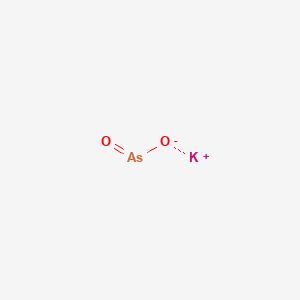
Calcium-40
Overview
Description
Calcium-40 is a naturally occurring isotope of calcium, which is an alkaline earth metal with the atomic number 20. It constitutes approximately 96.94 percent of naturally occurring calcium . This compound is stable and does not undergo radioactive decay, making it a significant isotope in various scientific and industrial applications .
Scientific Research Applications
Calcium-40 has a wide range of applications in scientific research:
Chemistry: Used as a tracer in chemical reactions to study reaction mechanisms and pathways.
Biology: Employed in studies of calcium metabolism and transport in biological systems.
Medicine: Utilized in diagnostic techniques, such as calcium imaging, to monitor calcium levels in the body.
Mechanism of Action
Safety and Hazards
Preparation Methods
Synthetic Routes and Reaction Conditions: Calcium-40 can be isolated from natural calcium sources through isotope separation techniques. One common method is the use of mass spectrometry, which separates isotopes based on their mass-to-charge ratio. Another method involves chemical processes that exploit slight differences in the chemical behavior of calcium isotopes.
Industrial Production Methods: In industrial settings, this compound is typically obtained through the fractional distillation of calcium compounds. This process involves converting calcium compounds into a gaseous state and then separating the isotopes based on their boiling points. The production of this compound is often carried out in specialized facilities equipped with advanced separation technologies.
Types of Reactions:
Oxidation: this compound reacts with oxygen to form calcium oxide (CaO). This reaction is exothermic and occurs readily at elevated temperatures. [ 2 \text{Ca} + \text{O}_2 \rightarrow 2 \text{CaO} ]
Reduction: this compound can be reduced from its compounds using strong reducing agents like sodium or magnesium.
Substitution: this compound can undergo substitution reactions with halogens to form calcium halides, such as calcium chloride (CaCl₂). [ \text{Ca} + \text{Cl}_2 \rightarrow \text{CaCl}_2 ]
Common Reagents and Conditions:
Oxygen: Used in oxidation reactions to form calcium oxide.
Halogens: Used in substitution reactions to form calcium halides.
Strong Reducing Agents: Used in reduction reactions to isolate calcium from its compounds.
Major Products:
Calcium Oxide (CaO): Formed from oxidation reactions.
Calcium Halides (e.g., CaCl₂): Formed from substitution reactions.
Comparison with Similar Compounds
- Calcium-42
- Calcium-43
- Calcium-44
- Calcium-46
- Calcium-48
Comparison: Calcium-40 is unique due to its high natural abundance and stability. Unlike some other calcium isotopes, such as calcium-41, which is radioactive, this compound does not undergo radioactive decay, making it more suitable for long-term studies and applications. Additionally, this compound’s stable nature allows it to be used in a wide range of scientific and industrial applications without the concerns associated with radioactivity .
Properties
IUPAC Name |
calcium-40 | |
|---|---|---|
| Source | PubChem | |
| URL | https://pubchem.ncbi.nlm.nih.gov | |
| Description | Data deposited in or computed by PubChem | |
InChI |
InChI=1S/Ca/i1+0 | |
| Source | PubChem | |
| URL | https://pubchem.ncbi.nlm.nih.gov | |
| Description | Data deposited in or computed by PubChem | |
InChI Key |
OYPRJOBELJOOCE-IGMARMGPSA-N | |
| Source | PubChem | |
| URL | https://pubchem.ncbi.nlm.nih.gov | |
| Description | Data deposited in or computed by PubChem | |
Canonical SMILES |
[Ca] | |
| Source | PubChem | |
| URL | https://pubchem.ncbi.nlm.nih.gov | |
| Description | Data deposited in or computed by PubChem | |
Isomeric SMILES |
[40Ca] | |
| Source | PubChem | |
| URL | https://pubchem.ncbi.nlm.nih.gov | |
| Description | Data deposited in or computed by PubChem | |
Molecular Formula |
Ca | |
| Source | PubChem | |
| URL | https://pubchem.ncbi.nlm.nih.gov | |
| Description | Data deposited in or computed by PubChem | |
DSSTOX Substance ID |
DTXSID50161493 | |
| Record name | Calcium, isotope of mass 40 | |
| Source | EPA DSSTox | |
| URL | https://comptox.epa.gov/dashboard/DTXSID50161493 | |
| Description | DSSTox provides a high quality public chemistry resource for supporting improved predictive toxicology. | |
Molecular Weight |
39.9625908 g/mol | |
| Source | PubChem | |
| URL | https://pubchem.ncbi.nlm.nih.gov | |
| Description | Data deposited in or computed by PubChem | |
CAS No. |
14092-94-5 | |
| Record name | Calcium, isotope of mass 40 | |
| Source | ChemIDplus | |
| URL | https://pubchem.ncbi.nlm.nih.gov/substance/?source=chemidplus&sourceid=0014092945 | |
| Description | ChemIDplus is a free, web search system that provides access to the structure and nomenclature authority files used for the identification of chemical substances cited in National Library of Medicine (NLM) databases, including the TOXNET system. | |
| Record name | Calcium, isotope of mass 40 | |
| Source | EPA DSSTox | |
| URL | https://comptox.epa.gov/dashboard/DTXSID50161493 | |
| Description | DSSTox provides a high quality public chemistry resource for supporting improved predictive toxicology. | |
Synthesis routes and methods I
Procedure details





Synthesis routes and methods II
Procedure details






Synthesis routes and methods III
Procedure details
















Synthesis routes and methods IV
Procedure details









Disclaimer and Information on In-Vitro Research Products
Please be aware that all articles and product information presented on BenchChem are intended solely for informational purposes. The products available for purchase on BenchChem are specifically designed for in-vitro studies, which are conducted outside of living organisms. In-vitro studies, derived from the Latin term "in glass," involve experiments performed in controlled laboratory settings using cells or tissues. It is important to note that these products are not categorized as medicines or drugs, and they have not received approval from the FDA for the prevention, treatment, or cure of any medical condition, ailment, or disease. We must emphasize that any form of bodily introduction of these products into humans or animals is strictly prohibited by law. It is essential to adhere to these guidelines to ensure compliance with legal and ethical standards in research and experimentation.


![(2R)-2-[(1R)-1-Carboxyethoxy]propanoic acid](/img/structure/B76392.png)












